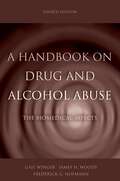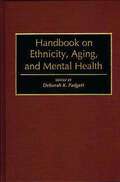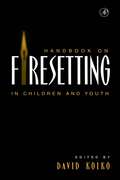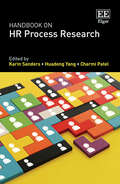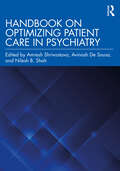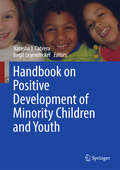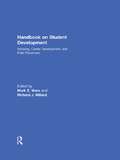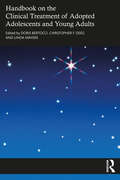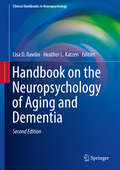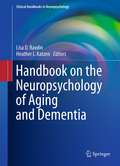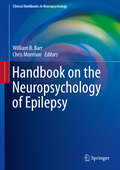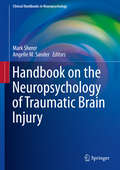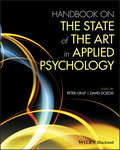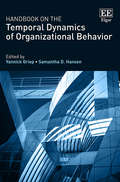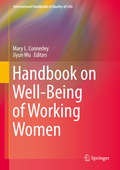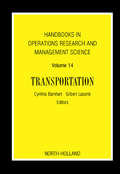- Table View
- List View
A Handbook on Drug and Alcohol Abuse: The Biomedical Aspects
by Gail Winger James H. Woods Frederick G. HofmannThis comprehensive text on the pharmacological, medical, and legal aspects of drug abuse has been thoroughly updated for the Fourth Edition, and a new chapter on club drugs added. The chapter on medical effects was completely rewritten to focus on infections that develop in i.v. drug abusers, and information on the international regulation of drug use was added to the chapter on drug abuse and the law. The book is written at a level appropriate for upper level undergraduate students, graduate or medical students, and drug counselors. All major drugs of abuse are covered: tobacco, opioids, central stimulants (including cocaine, amphetamine, and caffeine), alcohol and other sedatives, marijuana, club drugs (MDMA, GHB, and ketamine), hallucinogens, and volatile solvents. For each type the authors discuss history and culture, the characteristic patterns of use, subjective and physiological effects, mechanisms of pharmacological action, and toxic effects. Epidemiological aspects are discussed as well as pharmacological treatment possibilities where applicable.
Handbook on Ethnicity, Aging, and Mental Health (Non-ser.)
by Deborah PadgettThis state-of-the-art, multi-disciplinary reference is the first to assess the empirical research and conceptual frameworks for understanding the mental health needs and services use of the ethnic elderly. Leading scholars, researchers, and clinicians in gerontology, epidemiology, psychiatry, psychology, sociology, anthropology, nursing, and social work appraise varying approaches, the demographics, the mental health status and service use of the ethnic elderly, and issues in the diagnosis, treatment, and mental health service delivery for the ethnic aged: for African Americans, American Indians, Asian and Pacific Islander Americans, and Hispanic/Latino Americans. This unique handbook is a valuable resource and text for students, teachers, and professionals in a broad array of fields and settings.The handbook considers such problems as Alzheimer's Disease, depression and problems of coping, culturally specific psychosocial nursing care programs, the role of culture and class in mental and physical co-morbidity among the elderly, and important life-course perspectives for specific groups. Students, teachers, and professionals in many fields and settings will find this unique handbook a valuable resource and text.
The Handbook on Female Criminality in the Former Yugoslav Countries
by Angelina Stanojoska Darko Dimovski Elena MaksimovaThis edited volume is the first volume that researches female criminality in the Balkan region and provides insights about patriarchal relations, gender roles, and female criminal behavior. The chapters provide research and data about crimes committed by females in Serbia, North Macedonia, Montenegro, Bosnia and Hercegovina, Croatia, and Slovenia. The chapters investigate topics such as: Long violence Social abuse and discrimination Life trajectories towards criminal behavior Women facing financial stress and dependence and how it relates to crime Women in the criminal justice system Examining the relationship between crime, gender, and the “modernization” of Balkan (ex-Yugoslavian) social structure, this volume is ideal for interdisciplinary criminology scholars specializing in the Balkans. Chapter 3 is available open access under a Creative Commons Attribution 4.0 International License via link.springer.com
Handbook on Firesetting in Children and Youth
by David J. KolkoThis text reference provides state-of-the-art information on juvenile firesetters and reviews the current research on youthful firesetters and arsonists. The work illustrates methods of fire scene investigation and assessment relating to child-parent and family factors. This information is then used to prescribe interventions with the individual along with community-wide programs. The work also provides current information on fire safety education and curricula, with explicit training materials. Finally, the book addresses the need for residential treatment centers and training schools on methods for handling firesetting youth and maintaining a fire safe environment.Presents a multidisciplinary approachDescribes and illusrates current tools and techniquesIncludes materials encouraging both fire safety and mental health interventionContributors are nationally known experts in their fieldCovers a full range of topics - content has both depth and breadth
Handbook on HR Process Research (Research Handbooks in Business and Management series)
This forward-thinking Handbook explores cutting-edge research on how employees within firms should be managed in order to increase their wellbeing and performance.Expert contributors explore an emerging stream of research in human resource management (HRM) which suggests that attention should be paid to how line managers implement HR practices and how employees perceive, understand and attribute these HR practices. Chapters consider the implications of employees‘ and leaders‘ HR attributions and their performance, HRM system strength, change, talent management and the role of line managers in the HRM process. Providing an overview of the current knowledge in the HR process research, the Handbook also discusses future avenues and directions for the field. Demonstrating the dynamics of how HR practices impact organisational and individual outcomes, this Handbook will be critical reading for scholars and students of human resource management, organisational behaviour and research methods in business and management. It will also be beneficial for HR professionals seeking to understand how they can increase the effectiveness of their HR management.
Handbook on Optimizing Patient Care in Psychiatry
by Amresh Shrivastava Avinash De Sousa Nilesh ShahThis handbook examines current mental health research, challenges in patient care, and advances in clinical psychiatry with the aim of improving approaches toward the screening of at-risk individuals, facilitating access to care, and supervising rehabilitation. Combining evidence-based research with clinical case studies, international experts provide detailed, holistic insights into our understanding of mental disorders through biological, social, interpersonal, and economical lenses. Models of intervention, prevention, and treatment are provided, along with methods for continued care and patient advocacy. Finally, experts analyze the future of psychiatric research and mental health care. Readers will gain greater understanding of the finer nuances of handling psychiatric cases and a holistic perspective of optimizing patient care within this field. This innovative book contributes to the development of community management of various psychiatric disorders and will be of interest to case managers, mental health workers, doctors, nurses, and many more.
Handbook on Optimizing Patient Care in Psychiatry
by Amresh Shrivastava Avinash De Sousa Nilesh ShahThis handbook examines current mental health research, challenges in patient care, and advances in clinical psychiatry with the aim of improving approaches toward the screening of at-risk individuals, facilitating access to care, and supervising rehabilitation. Combining evidence-based research with clinical case studies, international experts provide detailed, holistic insights into our understanding of mental disorders through biological, social, interpersonal, and economical lenses. Models of intervention, prevention, and treatment are provided, along with methods for continued care and patient advocacy. Finally, experts analyze the future of psychiatric research and mental health care. Readers will gain greater understanding of the finer nuances of handling psychiatric cases and a holistic perspective of optimizing patient care within this field. This innovative book contributes to the development of community management of various psychiatric disorders and will be of interest to case managers, mental health workers, doctors, nurses, and many more.
Handbook on Positive Development of Minority Children and Youth
by Natasha J. Cabrera Birgit LeyendeckerThis Handbook presents current research on children and youth in ethnic minority families. It reflects the development currently taking place in the field of social sciences research to highlight the positive adaptation of minority children and youth. It offers a succinct synthesis of where the field is and where it needs to go. It brings together an international group of leading researchers, and, in view of globalization and increased migration and immigration, it addresses what aspects of children and youth growing in ethnic minority families are universal across contexts and what aspects are more context-specific. The Handbook examines the individual, family, peers, and neighborhood/policy factors that protect children and promote positive adaptation. It examines the factors that support children’s social integration, psychosocial adaptation, and external functioning. Finally, it looks at the mechanisms that explain why social adaptation occurs.
Handbook on Pro-Environmental Behaviour Change
This timely Handbook provides a state-of-the-art overview of research on changing behaviour to become less environmentally harmful. Exploring how well-designed, contextually appropriate behaviour change interventions can work, it charts a path for future research that challenges traditional assumptions to maximise pro-environmental impact.Drawing together work from diverse perspectives and disciplines, this Handbook makes six key recommendations for anyone working towards a more sustainable society. Giving a critical perspective on existing ways of thinking about research and policy, leading global scholars examine behavioural change in the public and private sphere. Through empirical analysis and theoretical reflection, they review key success stories and identify where new ideas and approaches are needed. Chapters discuss cutting-edge issues including citizen science, effectiveness of behavioural interventions, norm nudges, public participation in climate policy, and children’s pro-environmentalism. The Handbook on Pro-Environmental Behaviour Change will be an invaluable resource for researchers and students of sustainability, social psychology, cultural and human geography, environmental governance, and natural resource management. It will also prove an essential guide for practitioners and activists seeking evidence-based strategies to induce change.
Handbook on Psychopathy and Law (Oxford Series in Neuroscience, Law, and Philosophy)
by Kent A. Kiehl Walter P. Sinnott-ArmstrongPsychopaths constitute less than 1% of the general population but over 20% of prison populations. They commit a disproportionate amount of crime and violence in society. Given that the economic burden of crime in the United States is estimated to be over $2.3 trillion per year, psychopaths likely constitute one of the most expensive mental health conditions known today. This volume chronicles the latest science of psychopathy and the various ways the condition intersects with the criminal justice system. From the modern techniques to assess the symptoms, to its utility in predicting violent recidivism, to the latest neuroscience youth and adults, and the most promising avenues for treatment, this volume captures the modern science of the condition and discusses ethical and legal issues surrounding psychopaths.
Handbook on Student Development: Advising, Career Development, and Field Placement
by Mark E. Ware Richard J. MillardBecause this book's main objective is to foster and promote student development, it should appeal to those who advise, counsel, and teach undergraduate and graduate students, particularly those in psychology, education, and other social sciences. Along with a plethora of stimulating ideas for practice and research, the book contains the results of research having immediate applications to students' educational and career direction needs. Readers will find more than 90 articles in this book distributed across three significant challenges to students' development: the academic, occupational, and personal. Further, the material presented has been organized around three distinct approaches to these challenges: advising, career development, and field placement activities. The source for these articles is the official journal, Teaching of Psychology, of Division Two of the American Psychological Association.
Handbook on Student Development: Advising, Career Development, and Field Placement
by Mark E. Ware Richard J. MillardBecause this book's main objective is to foster and promote student development, it should appeal to those who advise, counsel, and teach undergraduate and graduate students, particularly those in psychology, education, and other social sciences. Along with a plethora of stimulating ideas for practice and research, the book contains the results of research having immediate applications to students' educational and career direction needs. Readers will find more than 90 articles in this book distributed across three significant challenges to students' development: the academic, occupational, and personal. Further, the material presented has been organized around three distinct approaches to these challenges: advising, career development, and field placement activities. The source for these articles is the official journal, Teaching of Psychology, of Division Two of the American Psychological Association.
Handbook on the Clinical Treatment of Adopted Adolescents and Young Adults
by Doris Bertocci Christopher F. Deeg Linda MayersThis collection bridges the voices of international scholars and adopted persons to share knowledge about clinical practice with adopted people in adolescence and early adulthood. Coming at a time when countries are beginning to focus on adoption reform, this handbook is the first to address not only the external, systemic contributions to their developmental complexities but also the underlying, internal meanings of being adopted as children become adolescents and mature into adulthood. It explains how adopted clients differ from those not adopted and emphasizes the need for clinical research on adopted people in this older age group. Exploring how clinicians can understand their client’s clinical needs, it offers specific protocols and frameworks for assessment and necessary modifications in language and treatment. With a foreword by Miriam Steele, chapters examine the legal and sociopolitical cultures, policies, and practices in which adoption is embedded, calling for broad systemic change. Embracing theoretical, conceptual, and global perspectives, this handbook is written for clinicians in all disciplines, at all tiers of practice, administration, and training, identifying the key roles they can potentially play in expanding and better focusing our understanding of the psychology of being adopted.
Handbook on the Clinical Treatment of Adopted Adolescents and Young Adults
This collection bridges the voices of international scholars and adopted persons to share knowledge about clinical practice with adopted people in adolescence and early adulthood. Coming at a time when countries are beginning to focus on adoption reform, this handbook is the first to address not only the external, systemic contributions to their developmental complexities but also the underlying, internal meanings of being adopted as children become adolescents and mature into adulthood. It explains how adopted clients differ from those not adopted and emphasizes the need for clinical research on adopted people in this older age group. Exploring how clinicians can understand their client’s clinical needs, it offers specific protocols and frameworks for assessment and necessary modifications in language and treatment. With a foreword by Miriam Steele, chapters examine the legal and sociopolitical cultures, policies, and practices in which adoption is embedded, calling for broad systemic change. Embracing theoretical, conceptual, and global perspectives, this handbook is written for clinicians in all disciplines, at all tiers of practice, administration, and training, identifying the key roles they can potentially play in expanding and better focusing our understanding of the psychology of being adopted.
Handbook on the Neuropsychology of Aging and Dementia (Clinical Handbooks in Neuropsychology)
by Heather L. Katzen Lisa D. RavdinThis comprehensive update offers practical advice for professionals working inneuropsychology with older adults. Focusing on fundamentals, common issues,special considerations, and late-life cognitive disorders, respected names in this criticalspecialty address a wide range of presenting problems and assessment, diagnostic,and treatment concerns. Th roughout, coverage pays keen attention to detail, bringingreal-world nuance to large-scale concepts and breaking down complex processes intodigestible steps. And like its predecessor, the new Handbook features recommendationsfor test batteries and ends each chapter by extracting its “clinical pearls.”A sampling of the topics covered:• Assessment of depression and anxiety in older adults.• The assessment of change: serial assessments in dementia evaluations.• Elder abuse identifi cation in older adults.• Clinical assessment of postoperative cognitive decline.• Cognitive training and rehabilitation in aging and dementia.• Diff erentiating mild cognitive impairment and cognitive changes of normalaging.• Evaluating cognition in patients with chronic obstructive pulmonary disease.This Second Edition of the Handbook on the Neuropsychology of Aging and Dementiaoffers a wealth of expert knowledge and hands-on guidance for neuropsychologists,gerontologists, social workers, and other clinicians interested in aging. Th is can be avaluable reference for those studying for board certifi cation in neuropsychology as wellas a resource for veteran practitioners brushing up on key concepts in neuropsychologyof age related disorders.
Handbook on the Neuropsychology of Aging and Dementia (Clinical Handbooks in Neuropsychology)
by Lisa D. Ravdin and Heather L. KatzenWith the aging of the baby boomers and medical advances that promote longevity, older adults are rapidly becoming the fastest growing segment of the population. As the population ages, so does the incidence of age related disorders. Many predict that 15% - 20% of the baby-boomer generation will develop some form of cognitive decline over the course of their lifetime, with estimates escalating to up to 50% in those achieving advanced age. Although much attention has been directed at Alzheimer’s disease, the most common form of dementia, it is estimated that nearly one third of those cases of cognitive decline result from other neuropathological mechanisms. In fact, many patients diagnosed with Alzheimer’s disease likely have co-morbid disorders that can also influence cognition (i.e., vascular cognitive impairment), suggesting mixed dementias are grossly under diagnosed. The Clinical Handbook on the Neuropsychology of Aging and Dementia is a unique work that provides clinicians with expert guidance and a hands-on approach to neuropsychological practice with older adults. The book will be divided into two sections, the first addressing special considerations for the evaluation of older adults, and the second half focusing on common referral questions likely to be encountered when working with this age group. The authors of the chapters are experts and are recognized by their peers as opinion leaders in their chosen chapter topics. The field of neuropsychology has played a critical role in developing methods for early identification of late life cognitive disorders as well as the differential diagnosis of dementia. Neuropsychological assessment provides valuable clinical information regarding the nature and severity of cognitive symptoms associated with dementia. Each chapter will reinforce the notion that neuropsychological measures provide the clinician with sensitive tools to differentiate normal age-related cognitive decline from disease-associated impairment, aid in differential diagnosis of cognitive dysfunction in older adults, as well as identify cognitive deficits most likely to translate into functional impairments in everyday life.
Handbook on the Neuropsychology of Epilepsy (Clinical Handbooks in Neuropsychology)
by William B. Barr Chris MorrisonOnce feared and misunderstood even among the medical community, epilepsy has since largely been demystified. Besides the characteristic seizures, various cognitive, behavioral, and emotional difficulties are recognized as associated with the condition, and patients are finding relief in medical management and/or surgical intervention. Not surprisingly, neuropsychology has emerged as a major component in treatment planning, program development, and assessment of surgical candidates. Geared toward beginning as well as veteran clinicians, the Handbook on the Neuropsychology of Epilepsy offers readers a skills-based framework for assessment and treatment, using current evidence and standardized terminology. Expert coverage reviews widely-used methods for evaluating key aspects of patient functioning (MRI, MEG, electrocortical mapping, the Wada test), and presents guidelines for psychotherapeutic and cognitive remediation strategies in treating comorbid psychiatric conditions. Given the diversity of the patient population, additional chapters spotlight issues specific to subgroups including high- and low-functioning as well as geriatric and pediatric patients. This integrative hands-on approach benefits a range of practitioners across medical and neurological settings. Topics featured in the Handbook: Neuropsychological assessment across the lifespan. Evaluating the epilepsy surgical candidate: methods and procedures. The Wada test: current perspectives and applications. Assessing psychiatric and personality disorders in the epilepsy patient. Evaluation and management of psychogenic non-epileptic attacks. Neuropsychological assessment with culturally diverse patients. Practical and flexible in its coverage, the Handbook on the Neuropsychology of Epilepsy serves not only neuropsychologists and neurologists but also primary care physicians such as internists, family physicians, and pediatricians.
Handbook on the Neuropsychology of Traumatic Brain Injury (Clinical Handbooks in Neuropsychology)
by Mark Sherer Angelle M. SanderThis book collects and synthesizes the latest thinking on the condition in its variety of cognitive and behavioral presentations, matched by a variety of clinical responses. Acknowledging the continuum of injury and the multi-stage nature of recovery, expert contributors review salient research data and offer clinical guidelines for the neuropsychologist working with TBI patients, detailing key areas of impairment, brief and comprehensive assessment methods and proven rehabilitation strategies. Taken together, these chapters provide a framework for best serving a wide range of TBI patients (including children, elders, and patients in multidisciplinary settings) and model treatment that is evidence-based and relevant. A sample of the topics featured in the Handbook: Bedside evaluations in TBI.Outcome assessment in TBI.Collaborating with family caregivers in the rehabilitation of persons with TBI.Behavioral assessment of acute neurobehavioral syndromes to inform treatment.Pediatric TBI: assessment, outcomes, intervention.Special issues with mild TBI in veterans and active duty service members. Expanding professional knowledge on a topic that continues to grow in importance, the Handbook on the Neuropsychology of Traumatic Brain Injury is a premier resource, not only for neuropsychologists but also for other professionals in cognitive care, and trainees entering the field.
Handbook on the State of the Art in Applied Psychology
by Peter Graf David J. A. DozoisLearn the most up-to-date developments in applied psychology with one authoritative collection The Handbook on the State of the Art in Applied Psychology delivers 19 state-of-the-art addresses on a selected topic in applied psychology. Together, they constitute an up-to-date and authoritative reference that describes the most cutting-edge material in the most prominent domains of applied psychology. The accomplished academics and editors Dr. Peter Graf and Dr. David Dozois put the focus on areas where the most profound recent progress has been made. They also emphasize the link between science and practice, showcasing basic science research that has practical implications for real world problems. Readers will benefit from up-to-date research on topics as varied as occupational commitment and organizational productivity, forgiveness, shared cultural spaces, environmental decision making, and the early identification of reading problems. In addition to the papers included in the collection, the Handbook on the State of the Art in Applied Psychology features: An insightful preface focused on the theme of connecting basic research to practical solutions in the real world An overview of the chapters and their arrangement in the collection An author and subject index to assist readers in finding the information they seek A focus on the most cutting-edge advancements in the field of applied psychology, with an emphasis on the impact of technological innovation and increased recognition of cultural determinants of behavior Perfect for applied psychology researchers, workers, teachers, and students around the world, Handbook on the State of the Art in Applied Psychology also belongs on the bookshelves of anyone looking for an efficient way to get up to speed on the latest developments on a wide variety of relevant topics in applied psychology.
Handbook on the State of the Art in Applied Psychology
by Peter Graf David J. A. DozoisLearn the most up-to-date developments in applied psychology with one authoritative collection The Handbook on the State of the Art in Applied Psychology delivers 19 state-of-the-art addresses on a selected topic in applied psychology. Together, they constitute an up-to-date and authoritative reference that describes the most cutting-edge material in the most prominent domains of applied psychology. The accomplished academics and editors Dr. Peter Graf and Dr. David Dozois put the focus on areas where the most profound recent progress has been made. They also emphasize the link between science and practice, showcasing basic science research that has practical implications for real world problems. Readers will benefit from up-to-date research on topics as varied as occupational commitment and organizational productivity, forgiveness, shared cultural spaces, environmental decision making, and the early identification of reading problems. In addition to the papers included in the collection, the Handbook on the State of the Art in Applied Psychology features: An insightful preface focused on the theme of connecting basic research to practical solutions in the real world An overview of the chapters and their arrangement in the collection An author and subject index to assist readers in finding the information they seek A focus on the most cutting-edge advancements in the field of applied psychology, with an emphasis on the impact of technological innovation and increased recognition of cultural determinants of behavior Perfect for applied psychology researchers, workers, teachers, and students around the world, Handbook on the State of the Art in Applied Psychology also belongs on the bookshelves of anyone looking for an efficient way to get up to speed on the latest developments on a wide variety of relevant topics in applied psychology.
Handbook on the Temporal Dynamics of Organizational Behavior (Research Handbooks in Business and Management series)
by Samantha D. Hansen Yannick GriepFor more than a decade, organizational behavior scholars have highlighted the importance of studying phenomena through a temporal lens by focusing on the role of time and its various implications for research. When a phenomenon occurs, what aspects of the phenomena are being influenced, how these aspects are being influenced, and why this influence occurs are considerations of the utmost importance when trying to understand the full essence of organizational behavior. Handbook on the Temporal Dynamics of Organizational Behavior is designed to help scholars begin to address the temporal shortcomings in the extant organizational behavior literature. The handbook provides conceptual and methodological reasons to study organizational behavior from a dynamic perspective and offers new conceptual and theoretical insights on some of the most popular organizational behavior topics. By providing the methodological and analytical tools needed to translate dynamic ideas into dynamic reality, this handbook will become a guiding light for scholars, academic audiences, and evidence-based management practitioners who wish to tackle the challenges of dynamic organizational behavior research.
Handbook on Well-Being of Working Women (International Handbooks of Quality-of-Life)
by Mary L. Connerley Jiyun WuThis handbook provides an overview and synthesis of relevant literature related to the issue of the well-being of working women. This focus addresses a gap that currently exists in the quality-of-life and well-being fields. The work of the authors answers the following broad questions: Does gender matter in the well-being of working women? Do prejudices against and stereotypes of women still play a role in inter-personal interactions in the workplace that could hinder women from flourishing professionally? Does the organizational context, such as organizational culture, reward systems, and leadership, contribute to the well-being of working-women? What impact does the national context have on the well-being of working women? And finally, how can public policies help enhance the well-being of working women? These are important issues for academics, researchers, and graduate students interested in gender issues in the fields of management, sociology, psychology, social psychology, economics, and quality of life studies. Policy makers and practitioners will also find this book beneficial. Equitable treatment and outcomes for all, regardless of gender, remains a challenging goal to achieve, with various barriers in different contexts and different cultures, and this book provides strong coverage of this important topic of well-being of working women.
Handbooks in Operations Research and Management Science: Transportation (ISSN #Volume 14)
by Cynthia Barnhart Gilbert LaporteThis book contains eleven chapters describing some of the most recent methodological operations research developments in transportation. It is structured around the main transportation modes, and each chapter is written by a group of well-recognized researchers. Because of the major impact of operations research methods in the field of air transportation over the past forty years, it is befitting to open the book with a chapter on airline operations management. This book will prove useful to researchers, students, and practitioners in transportation and will stimulate further research in this rich and fascinating area.Volume 14 examines transport and its relationship with operations and management science11 chapters cover the most recent research developments in transportationFocuses on main transportation modes-air travel, automobile, public transit, maritime transport, and more
Handbuch Angewandte Psychologie für Führungskräfte: Führungskompetenz und Führungswissen
by Tobias Leuenberger Urs Jörg Andres Pfister Eric LippmannDas erfolgreiche Handbuch für Praktiker - bislang bekannt als "der Steiger-Lippmann" - fasst das gesamte, für Führungskräfte aller Ebenen relevante Wissen der Psychologie in einem Werk zusammen und ist, nun schon in der 5. Auflage mit neuem Herausgeberteam, ein bewährter Wegweiser in allen Führungssituationen, wie ein Blick auf die Themen des Buches zeigt: Leistungsbeeinflussung, Führung der eigenen Person, Kommunikation, Teamführung, Recruiting, Personalentwicklung, Motivation, Projektmanagement, Change Management, Konfliktmanagement, Coaching u.v.m. - all das funktioniert im Alltag nicht ohne Know-how aus der Psychologie! Auch zeitaktuelle Themen wie Umgang mit Verhaltensauffälligkeiten, Burnout etc., Managing Diversity, Virtuelle Führung oder Einsatz von Social Media u.a. sind enthalten.Eine sorgfältige didaktische Aufbereitung des Textes mit Checklisten, Fallbeispielen, Leitfragen, Arbeitsblättern u.a. erleichtert das Lesen.Herausgeber und Autoren sind erfahrene Praktiker in der Führungskräfteentwicklung und Dozenten am renommierten IAP Institut für Angewandte Psychologie in Zürich.
